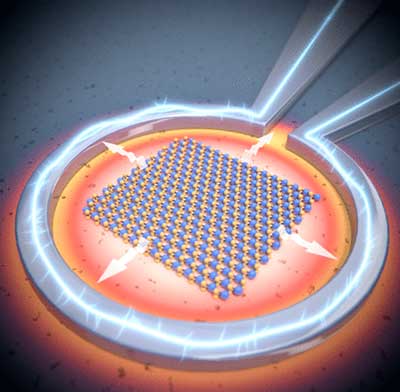| Jun 17, 2020 | |
A new platform to stretch 2D materials |
|
| (Nanowerk Spotlight) The electronic and optical properties of 2D materials can be controlled by mechanical deformations of their crystal structure. This route to tailor the properties of materials is called strain engineering and it is a rapidly evolving field of research in nanomaterials. | |
| Moreover, the possibility of using strain engineering to modify the electronic properties of 2D materials will open the door to envision so called straintronic devices (read more: "Atomically thin straintronic devices"). | |
| Straintronics, however, is somewhat hampered by technical issues related to the fast and reliable control of the applied strain. In fact, in order to exploit strain as a new tuning knob in straintronic devices the user needs to be able to modulate the applied strain in a fast, reproducible and reliable way. | |
| Researchers at the Materials Science Institute of Madrid, part of the Consejo Superior de Investigaciones Científicas (CSIC, the Spanish National Research Council), and the Universidad Autónoma de Madrid, have developed miniature heaters on top of polypropylene substrates. | |
| These microheaters can be used to control the thermal expansion of the substrate and thus operate as thermal actuators to apply biaxial strain. | |
| The results, published in Nano Letters ("Microheater Actuators as a Versatile Platform for Strain Engineering in 2D Materials") emphasize that these actuators are a versatile and straightforward platform to control the biaxial strain in atomically thin MoS2 layers. | |
 |
|
| Artistic representation of the microheater thermal actuator used to apply biaxial strain to a MoS2 flake. (Image: Enrique Sahagún, SCIXEL) | |
| “Our thermal strain actuators can reach a maximum biaxial strain of 0.64 % and they can be reliably modulated at frequencies up to 8 Hz,” explains Andres Castellanos-Gomez, Tenured Scientist at the Materials Science Institute of Madrid (CSIC). “The actuation speed is still modest, but we foresee further improvements by reducing the thickness of the polymer substrate and reducing the dimensions of the thermal actuators even further.” | |
| These microheater actuators also present other advantages for experiments requiring high mechanical stability. | |
| “Using these actuators, we can now vary the strain level all the way from 0% to 0.6% with a negligible spatial drift, while with other straining approaches the sample position changes quite substantially upon strain loading,” he adds. “This is particularly important for many experiments, like optical spectroscopy measurements, where traditional straining setups lead to constant repositioning and refocusing,” Castellanos-Gomez concludes. | |
| The research team demonstrated the operation of these thermal strain actuators by creating a small strain-driven optical modulator with a single layer MoS2. They show how by modulating the biaxial strain applied to the single layer MoS2 its reflectance and refractive index also changes following the strain modulation. | |
| The authors point our that these microheater strain actuators can also be employed to control the strain of other 2D materials. | |
|
Provided by Instituto de Ciencia de Materiales de Madrid as a Nanowerk exclusive
|
|
|
Become a Spotlight guest author! Join our large and growing group of guest contributors. Have you just published a scientific paper or have other exciting developments to share with the nanotechnology community? Here is how to publish on nanowerk.com. |
|
